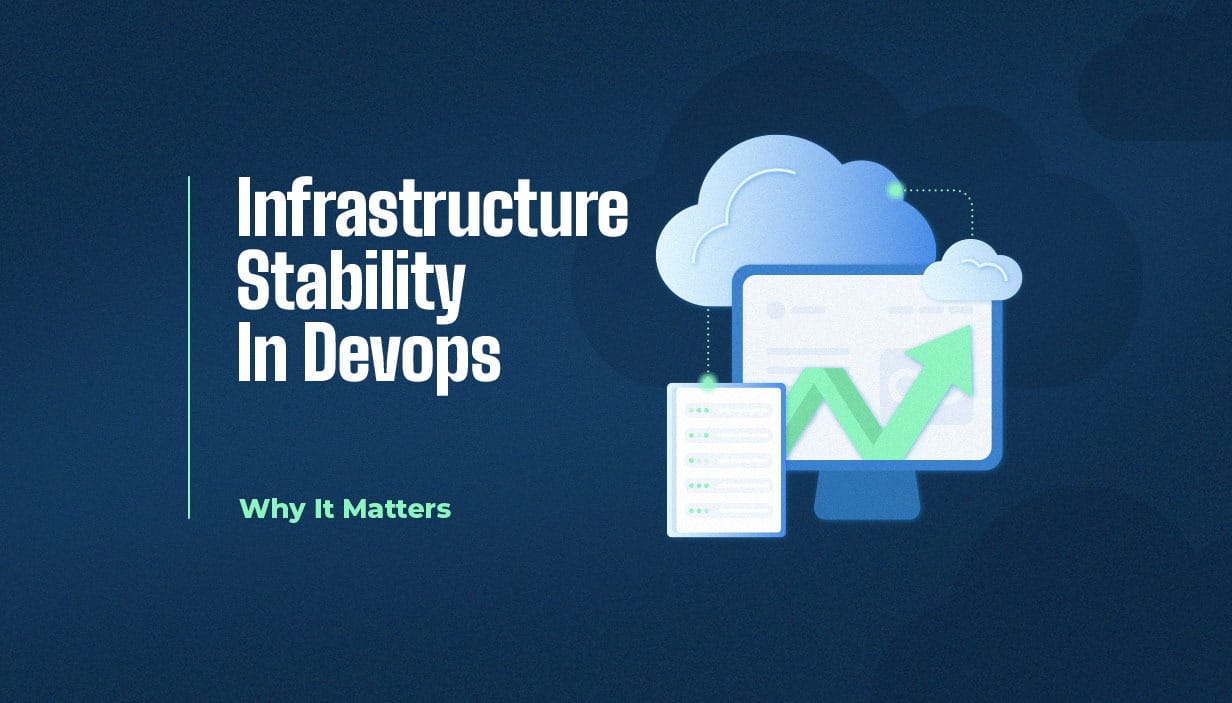Infrastructure stability in DevOps is more than just a technical goal, it’s a business necessity. Stable infrastructure underpins reliable software delivery, sustained uptime, and a seamless customer experience. As organizations increasingly rely on rapid releases and continuous integration, ensuring that your DevOps infrastructure is robust and resilient has become a top priority.
What is Infrastructure Stability in DevOps?
Infrastructure stability in DevOps refers to the ability of the underlying systems, tools, and processes to consistently support development and operations without unexpected failures or disruptions.
IT infrastructure serves as the foundation for stable DevOps practices, playing a critical role in supporting business continuity and operational efficiency. Stable infrastructure ensures that applications run smoothly, updates are delivered reliably, and teams can innovate without being held back by downtime or performance issues. This stability directly impacts business agility, customer satisfaction, and overall operational efficiency.
Key Components of Stable DevOps Infrastructure and Monitoring Tools
Infrastructure as Code IaC
Infrastructure as Code (IaC) is a foundational principle for stable DevOps environments. By managing and provisioning infrastructure through code, teams achieve consistency, repeatability, and rapid recovery from failures. Configuration management tools play a critical role in maintaining consistent system configurations, preventing downtime, and supporting operational efficiency. IaC reduces manual intervention, lowers the risk of configuration drift, and accelerates deployment cycles.
Automation and Orchestration
Automation is at the core of modern DevOps practices, enabling the automation of manual processes and repetitive tasks to improve efficiency and scalability. Automated processes, from provisioning to deployment, minimize human error and streamline complex workflows. Orchestration tools coordinate these automated tasks, ensuring that resources are allocated efficiently and systems remain stable even as demands fluctuate. To further enhance your automation strategy, explore DevOps automation solutions.
Monitoring and Logging
Proactive monitoring and centralized logging provide real time insights into system health and performance. By tracking metrics, detecting anomalies, and capturing system events, teams can quickly identify and resolve issues before they escalate. Effective monitoring is crucial for maintaining high availability and minimizing downtime.
Continuous Integration and Continuous Deployment CI/CD
CI/CD pipelines automate the building, testing, and deployment of code, ensuring that changes are delivered to production reliably and consistently. Continuous delivery automates the software development lifecycle, enabling faster and more reliable updates. These practices reduce integration headaches, speed up release cycles, and maintain the stability of applications throughout their lifecycle. Test automation frameworks help reduce manual testing, improving efficiency, consistency, and early detection of issues.
Cloud and Containerization
Cloud platforms and container technologies offer scalability, flexibility, and enhanced stability. Containers encapsulate applications and their dependencies, ensuring consistent behavior across environments. For organizations managing complex cloud environments, robust cloud infrastructure management is essential for maintaining stability.
Strategies to Achieve and Maintain Infrastructure Stability with Configuration Management
Automated Resource Scaling
Dynamic scaling allows infrastructure to respond automatically to changes in workload, optimizing resource utilization and maintaining performance during peak demand.
Immutable Infrastructure
Immutable infrastructure principles dictate that once a component is deployed, it is never modified. Instead, updates are made by replacing components entirely. This approach eliminates configuration drift and ensures that environments remain consistent and predictable.
Security Automation
To enhance security measures early in the development process, it is essential to integrate security automation into DevOps workflows and CI/CD pipelines. Integrating security checks into automated pipelines helps detect and remediate vulnerabilities early in the development lifecycle. Automated security practices enhance compliance and reduce the risk of breaches. For teams operating in regulated industries, adopting cloud compliance frameworks is vital.
Performance Testing in Production Like Environments
Testing infrastructure in environments that closely mirror production uncovers potential performance bottlenecks and ensures readiness for real-world conditions.
Collaborative Culture and Communication
Promoting open communication between development and operations teams fosters a culture of shared responsibility. Collaborative practices help teams respond quickly to incidents and continuously improve infrastructure stability.
Security and Compliance in DevOps Infrastructure
Security and compliance are foundational to a resilient DevOps infrastructure, ensuring that software development and deployment processes remain protected from threats and aligned with regulatory requirements. By embedding automated security checks and robust logging solutions throughout the development lifecycle, DevOps teams can proactively identify and address security vulnerabilities before they lead to system failures.
This approach enables teams to maintain the integrity of their systems, safeguard sensitive data, and reduce the risk of costly security incidents. Prioritizing security and compliance not only strengthens the infrastructure but also builds customer trust and supports long-term business success.
Performance and Scalability Considerations
Optimizing performance and scalability is essential for maintaining a robust DevOps infrastructure that meets evolving customer demands. Leveraging advanced monitoring tools and conducting regular performance testing help DevOps teams detect and resolve performance bottlenecks, ensuring that infrastructure components deliver consistent system performance.
Automated scaling and intelligent resource allocation allow teams to respond dynamically to workload fluctuations, minimizing downtime and preventing service interruptions. Continuous monitoring and rapid feedback loops further enhance system stability, enabling teams to make data-driven improvements that drive business success and keep pace with user expectations.
Cloud and Cost Management for Stable Infrastructure
Effective cloud and cost management are critical for sustaining a stable and efficient DevOps infrastructure. Implementing cost optimization strategies, such as automated resource scaling, streamlined infrastructure provisioning, and the use of automation tools, helps DevOps teams control infrastructure costs while maintaining optimal performance.
Cloud-based solutions offer the flexibility and scalability needed to deploy software updates quickly and adapt to shifting business needs. By integrating version control and minimizing manual setup, teams reduce human error and accelerate the development process.
These best practices enable teams to achieve cost efficiency, improved efficiency, and a faster time to market, ultimately securing a competitive edge.
Culture and Communication in DevOps Teams
A collaborative culture and open communication are the backbone of high-performing DevOps teams. By delegating tasks effectively, embracing continuous testing, and establishing faster feedback loops, teams can create streamlined workflows that minimize downtime and enhance productivity. Fostering a culture of continuous learning and improvement encourages team members to refine processes and optimize infrastructure together. When teams communicate openly and collaborate across all stages of the development and deployment lifecycle, they break down silos and enable seamless teamwork.
This collaborative approach not only enables teams to deliver high-quality software but also drives business success through more efficient and reliable operations.
Common Challenges to Infrastructure Stability in DevOps
Achieving and maintaining stability is not without obstacles:
- Tool sprawl can complicate integration and increase maintenance overhead.
- Managing complexity and frequent changes requires disciplined processes.
- Organizational silos and resistance to change may hinder collaboration.
Addressing these challenges demands a combination of technical solutions and cultural shifts.
Best Practices for Ensuring Infrastructure Stability and Continuous Integration
- Capacity Planning: Use data-driven approaches to anticipate resource needs and avoid bottlenecks.
- Automated Provisioning and Deployment: Streamline setup and updates to minimize manual steps and reduce errors.
- Continuous Testing and Feedback Loops: Integrate testing throughout the pipeline to catch issues early and adapt quickly.
- Optimized Database and Cost Management: Regularly review database performance and leverage cloud cost optimization to ensure efficient resource usage.
If you’re considering moving workloads to the cloud, a smooth cloud migration process can further improve your infrastructure’s stability and scalability.
Measuring Success: Metrics and KPIs for Infrastructure Stability
Tracking the right metrics and KPIs is a key aspect of effective DevOps infrastructure management, providing DevOps teams with valuable insights into system stability and overall performance. By monitoring deployment frequency, gathering user feedback, and assessing system stability, teams can measure success and identify opportunities for improvement.
Continuous monitoring and rapid feedback loops support ongoing optimization, ensuring that infrastructure remains responsive and resilient. Focusing on these metrics allows teams to refine their processes, enhance the software delivery process, and ultimately achieve business success through reliable and high-quality software products.
Real-World Examples and Use Cases
Many organizations have transformed their software delivery by embracing infrastructure stability best practices. For example, companies that adopted IaC and automated monitoring reported fewer outages and faster recovery times. Others that implemented immutable infrastructure and CI/CD pipelines saw significant improvements in deployment reliability and system uptime.
Infrastructure stability in DevOps is the foundation for reliable, efficient, and innovative software delivery. By combining automation, monitoring, collaboration, and modern cloud practices, organizations can build resilient systems that support rapid change and growth. Embrace these best practices to ensure your DevOps infrastructure remains robust, scalable, and ready for the challenges of tomorrow.


